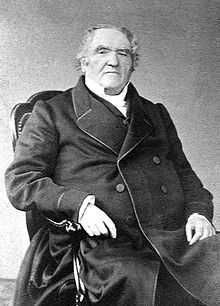Jean-Pierre Falret

Jean-Pierre Falret (26 April 1794 – 28 October 1870) was a French psychiatrist. He was born and died in Marcilhac-sur-Célé.[1]
In 1811 he began his medical studies in Paris, where he was inspired by the work of Philippe Pinel (1745–1826) and Jean Étienne Dominique Esquirol (1772–1840). In 1819 he obtained his medical doctorate, afterwards establishing a mental institution with Félix Voisin (1794–1872) at Vanves (1822). In 1831 was appointed chef de l’hospice at the Salpêtrière, a position he maintained until his retirement in 1867.
In 1851 he published an article describing a condition he called la folie circulaire (circular insanity), of which a patient would experience cycles of manic excitement and cycles of depression. Falret's description is considered to be the earliest documented diagnosis of what today is known as a bipolar affective disorder.[2]
Falret believed in the dualistic nature of the individual, and a separation of body and soul. He proposed that when the soul and a diseased condition interact, a phenomenon he called novum organon appeared. Accordingly, this manifestation of the novum organon created disturbances of the soul and caused mental illness. He believed that this mental condition could not be remedied by somatic treatment alone, but mainly through "psychic" moral methods.
With psychiatrist Ernest-Charles Lasègue (1816–1883), he diagnosed a communal psychotic disorder sometimes referred to as "Lasègue-Falret syndrome" (folie à deux). The syndrome is characterized by the coincidental appearance of psychotic symptoms in family members while living together, as well as retention of the symptoms when the individuals are separated. This syndrome can also involve a situation where a diseased family member transmits psychotic symptoms to healthy members of the family. The two doctors published their findings in a treatise called La folie à deux ou folie communiquée.[3]
Today the Le Centre Hospitalier Jean-Pierre Falret is a psychiatric hospital system serving the department of Lot.[4]
An Eminent Humanist
Being a fierce opponent of psychiatric reductionism depriving the mental patients of their rights, Falret was fighting against injustice by proposing a deeply humane approach respecting the persons with mental problems and open to society. Upon visiting the asylums in England and Scotland in 1835, he actively contributed to the preparation of the famous law as of June 30, 1838 aimed to re-establish the civil rights of the mentally ill in order to make them full-fledged citizens. A true pioneer, he was convinced that "the mental patients could be cured and that providing them with their place in society and workplace would guarantee their safety."[5]
"All the most unfortunate circumstances are reuniting so that to dishearten the convalescent mental patients on their way back to the world. The family does not want or cannot accept them anymore; society is rejecting them in terror, and, without the sufficient reaction capacity, they are forced to create ... a new reality... The mental patients are incapable of surmounting so many obstacles. As a result, people easily accuse them of immorality, crimes, or suicide attempts, or the mentally affected are very quickly falling back to the cruel illness where they were so successfully hiding themselves earlier."[5]
Being aware of the fragility of his patients and the risks of relapse, he founded in 1841 "The Patronage Society for the Mental Patients Cured in the Salpêtrière Hospital" ("La Société de Patronage pour les Aliénés sortis guéris de l’Hôpital de la Salpêtrière"). The name of this society was subsequently changed to "The Falret Charity" ("L’Œuvre Falret").
Written works
In 1845 Falret visited the Illenau asylum near Achern in the Grand Duchy of Baden, publishing Visite a l'établissement d'aliénés d'Illenau : (prés Achern, grand-duché de Bade), et considérations générales sur les asiles d'aliénés as a result of his experience. In 1865 he was made on honorary member of the Société médicale allemande de Paris (German Medical Society of Paris).[6][1]
- Recherches statistiques sur les aliénés, les suicides et les morts subites (Memoir presented to the Académie des sciences in 1828/1829; a prize-winning paper that earned him the membership of the Académie de Médecine.
- De l’aléniation mentale, (1838) – On mental illness.
- Du délire, (1839) – On delirium.
- De la folie circulaire ou forme de maladie mentale caracterisée par alternative régulière de la manie et de la melancholie, (1851) – "Circular madness" or a form of mental malady characterized by regular alternations of mania and melancholy.
- Mémoire sur la folie circulaire, forme de la maladie mentale caractérisée par la reproduction successive et régulière de l’état maniaque, de l’état mélancolique, et d’un intervalle lucide plus ou moins prolongé, (Bulletin de l'Académie impériale de médecine 19: 382–400), (1854) – Memoir of circular madness, etc.
- De la non-existence de la monomanie, (1854) – The non-existence of monomania.
- Du traitement général des aliénés, (1854) – General treatment of insanity.
Notes
- ↑ 1.0 1.1 FALRET (Jean Pierre). BIU Santé, Paris
- ↑ "[Circular insanity, 150 years on]". Bull Acad Natl Med. 188 (2): 275–84. 2004. PMID 15506718.
- ↑ Lasègue-Falret syndrome at Who Named It
- ↑ Le Centre Hospitalier Jean-Pierre Falret. icm46.fr
- ↑ 5.0 5.1 Jean-Pierre Falret, un fondateur visionnaire
- ↑ WorldCat Title Visite a l'établissement d'aliénés d'Illenau
References
- Jean-Pierre Falret at Who Named It
Further reading
- Pichot, P (2004). "Circular insanity, 150 years on". Bulletin de l'Academie nationale de medecine 188 (2): 275–84. PMID 15506718.
- Falret, Jean-Pierre (1854). "Mémoire sur la folie circulaire". Bulletin de l'Académie Imperiale de Médecine 19: 382–400.
|